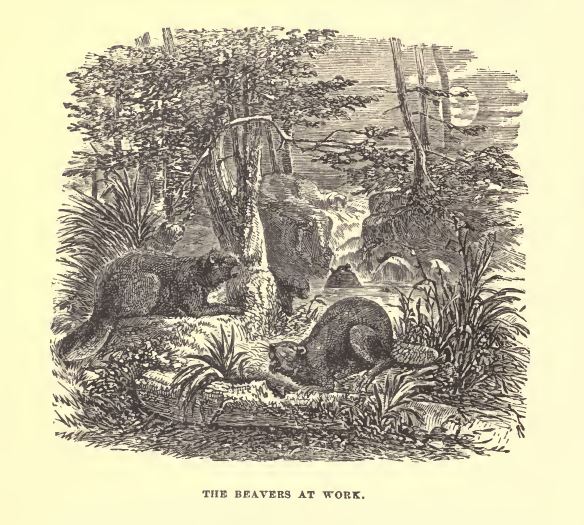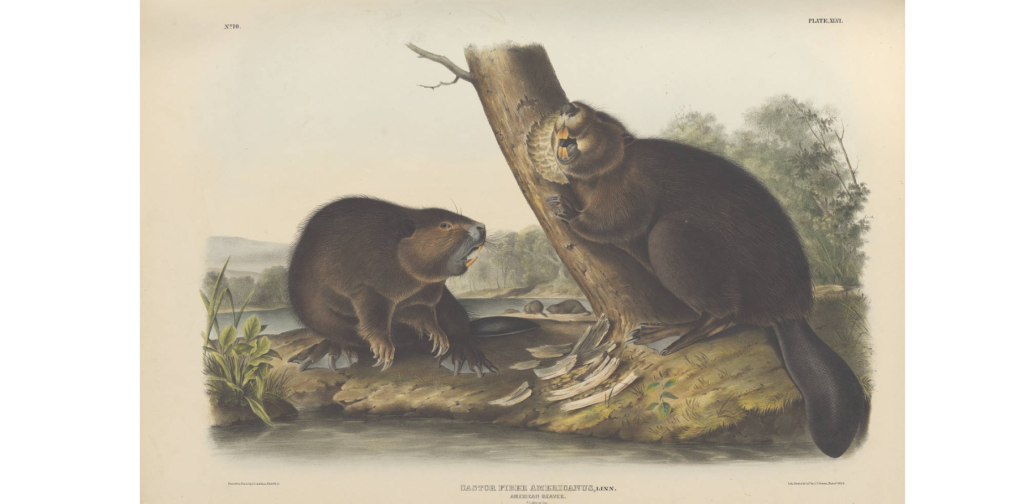American Animals Part I: The Beaver
By Jacob Abbott
Annotations by Josh Benjamin

We propose to give a short series of articles upon the habits of some of the animals found in America, as the buffalo, the eagle, the alligator, &c. These sketches are taken from Abbott’s “Aboriginal America.” We give this week
THE BEAVER.
One of the most remarkable of the animals found in America is the beaver. Species nearly resembling the American beaver formerly existed in the old world, but they have long been nearly or quite extinct. The class of animals to which the beaver belongs is common all over the world, namely, the class of Rodentia, which means gnawing animals. The beaver is the greatest gnawer of them all.
His cutting teeth are broad and flat, and are brought to so sharp and hard an edge that the Indians were accustomed to set them in handles and use them for cutting instruments before they obtained iron and steel from the Europeans. It is said that by means of these teeth the beavers can cut off a stem in the woods as big as a walking stick at a single bite. By more continued efforts they can fell trees of very considerable size, not greater, however, than eight or ten inches in diameter, though one trapper in the service of a fur company says he has seen trunks eighteen inches in diameter cut through by them.
The beaver has acquired a very extensive fame among mankind, the foundation of which is two-fold. First, the exceeding softness and richness of his fur, which made his skin very valuable as clothing to the native tribes before Europeans came to the country, and which have since caused it to be still more highly valued by civilized nations all over the world; and secondly, his distinguished reputation as a builder. Both these characters of the animal result from the same cause, namely this, that he is intended to live in a very cold climate, that is, a climate which is very cold for half the year, and to get his living from the roots of plants growing under water, which, during the cold season, is covered with ice from one to three feet thick. To meet these exigencies he is provided with an extremely thick and soft fur to protect him in his winter excursions upon the land, and with certain very remarkable building instincts, by which he is enabled at all times, however cold the weather and however thick the ice, to procure access to the water.
The first object of the beaver in his engineering operations, is to keep the water deep in the stream that he inhabits, in order to prevent its freezing to the bottom. To effect this he forms a company, and the whole band proceed to build a dam. They gnaw down trees and bushes and drag them into the stream at the place which they have chosen for the dam, and pack them together in a close and impenetrable mass ten or twelve feet wide at the bottom, and diminishing gradually to the top. As they proceed they fill up all the interstices of the work with stones, gravel, mud, turf, roots, and everything else that they can bring. Of course a great deal of their work is washed away by the current while they are building, but by means of their indomitable perseverance, they finally succeed, and a massive and permanent obstruction to the stream is created. In process of time the trunks and stems of trees which they have introduced into their work decay, and the whole settles and consolidates into a permanent bank, which endures sometimes for centuries. Of course, so long as the pond is occupied the dam needs constant watching and frequent repairs, but this work the company always attend to in the most prompt and systematic manner.
In laying the materials of which the dam is composed the beavers go continually to and fro over their work, trampling down the soft substances with their paws, and patting them with their broad tails. This patting motion of their tails, which they make instinctively when they walk about upon the ground, gave rise to the story that the beaver uses his tail as a trowel. This, though it is not literally and exactly true, is, after all, not far from the truth, for the effect of the patting is analogous to that produced by the trowel of the mason in laying stones in mortar.

Besides the dam, the beaver builds what may be called houses on the bank, where he can live during the winter sheltered from the cold, and protected from the wolves and similar wild animals that would otherwise prey upon him. These houses are built of logs of wood formed from the trunks of trees, which the beavers gnaw down in the adjoining forests, and then cut to proper lengths for their purpose. They dig in the ground to get good foundations, arid then build up walls four or five feet high, much in the same way as they construct the dams. They then lay other trunks of trees across from one wall to the other, and cover the roof thus formed with stones, bushes, moss, mud, and other similar materials, and smooth the whole over at last with their paws and their tail, so as to make a sort of mound of their work, with a hollow in the centre. The whole structure is so solid, and all its parts so closely compacted together, that the wolverines and wild cats cannot get in. It is very difficult even for men to break through such a solid mass.
From these habitations subterranean passages run in various directions — some opening into the pond under the ice, so as to afford the inhabitants free access and egress to the water at all times, and others lead to holes and caverns which the animals make as places of retreat from their enemies when they are alarmed, and perhaps for warmth in times of extreme cold.
It is a very curious circumstance that the beavers do all their work in the night, and thus no person can watch them at their operations except at a great disadvantage. In the day time they keep very quiet. Their motive, probably, in thus arranging their time, as far as action prompted by such animal instincts may be said to have a motive, is doubtless to avoid attracting the attention of their enemies.
The beavers were once very numerous throughout the whole northern portion of the territory now occupied by the United States. In all the settled parts of the country, however, they have nearly or entirely disappeared; and so valuable are their skins, and so closely do the hunters and trappers follow up the work of taking them, that it will not be many years, if the present state of things continues, before the whole race will be completely exterminated.
Abbott, jacob. “American Animals.” Youth’s companion 35, no. 22 (June 1861): 92.
Contexts
Youth’s Companion excerpted this selection from Jacob Abbott’s longer work, American History Volume I: Aboriginal America, published in 1860 as an illustrated book with ten chapters: “Types of Life in America,” “Face of the Country,” “Remarkable Plants,” “Remarkable Animals,” “The Indian Races,” “The Indian Family,” “Mechanic Arts,” “Indian Legends and Tales,” “Constitution and Character of the Indian Mind,” and “The Coming of the Europeans.” Abbott intended his series to be a complete overview of American history that began with the geography, flora and fauna, and indigenous people as indicative of the “earliest periods” of the country. Several more volumes followed, titled Discovery of America, The Southern Colonies, The Northern Colonies, Wars of the Colonies, Revolt of the Colonies, War of the Revolution, and Washington.
Abbott’s introduction reads:
“IT is the design of this work to narrate, in a clear, simple, and intelligible manner, the leading events connected with the history of our country, from the earliest periods, down, as nearly as practicable, to the present time. The several volumes will be illustrated with all necessary maps and with numerous engravings, and the work is intended to comprise, in a distinct and connected narrative, all that it is essential for the general reader to understand in respect to the subject of it, while for those who have time for more extended studies, it may serve as an introduction to other and more copious sources of information.
The author hopes also that the work may be found useful to the young, in awakening in their minds an interest in the history of their country, and a desire for further instruction in respect to it. While it is doubtless true that such a subject can be really grasped only by minds in some degree mature, still the author believes that many young persons, especially such as are intelligent and thoughtful in disposition and character, may derive both entertainment and instruction from a perusal of these pages.”
Definitions from Oxford English Dictionary:
exigency: What is needed or required; a thing wanted or demanded; a requirement, a necessity.
Resources for Further Study
- The full text of Abbott’s book is available at the Internet Archive.
- Stronger, Truer, Bolder: American Children’s Writing, Nature, and the Environment by Karen Kilcup discusses this text on pages 154-56 and Jacob Abbott on pages 89-92 and 130-40.
- Abbott was a prolific writer of children’s books, including his popular series centered around the Rollo character, which he intended as entertainment, language practice, and examples of reason and morality.
- The National Wildlife Foundation has a brief overview of the American beaver.
Contemporary Connections
Once declining in number due to the fur trade, American beavers are gaining attention for their effects on the environments in which they live and what we can learn from them about ecosystem management.
- Environmental journalist Ben Goldfarb wrote an award-winning book about beavers and covered beaver management in the Pacific Northwest.
- Stacy Passmore’s article considers the role of beavers in water systems.